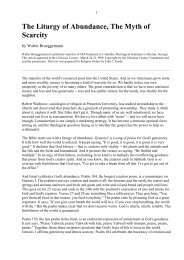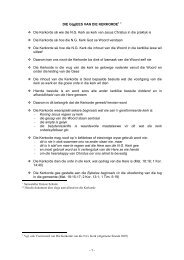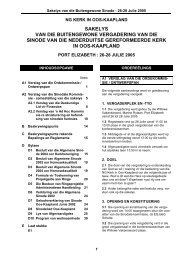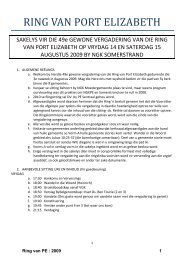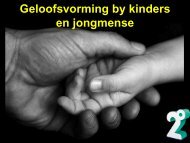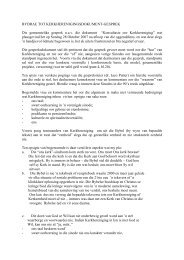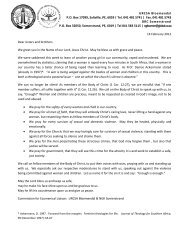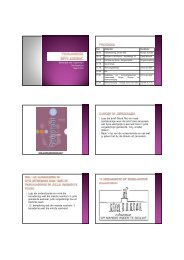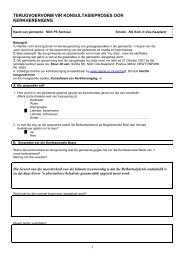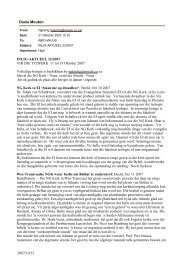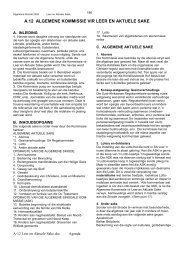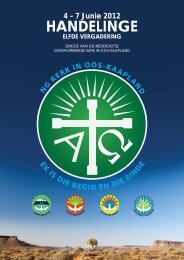Create successful ePaper yourself
Turn your PDF publications into a flip-book with our unique Google optimized e-Paper software.
3.12.<br />
1recognize the essential identity of the WCC as a fellowship of churches which call one another<br />
to visible unity <strong>in</strong> one faith and <strong>in</strong> one eucharistic fellowship, expressed <strong>in</strong> worship and common life,<br />
through witness and service to the world;<br />
3.12.2<br />
enumerate the most important areas of concern <strong>in</strong> which the churches through the Council<br />
pursue this primary purpose;<br />
3.12.3<br />
make clear that the Council as a fellowship of churches is an organization through which its<br />
members act together, not a body which acts separately from the churches;<br />
3.12.4<br />
recognize facets of the ecumenical vocation which have taken on a higher profile <strong>in</strong> recent<br />
years, <strong>in</strong>clud<strong>in</strong>g concerns for uphold<strong>in</strong>g the <strong>in</strong>tegrity of creation, relat<strong>in</strong>g to people of other faiths and<br />
promot<strong>in</strong>g processes of education which enable Christians to th<strong>in</strong>k and act ecumenically;<br />
3.12.5<br />
emphasize the Council's vocation of strengthen<strong>in</strong>g the one ecumenical movement, not only<br />
through official organizational ties but also by way of support<strong>in</strong>g other ecumenical <strong>in</strong>itiatives, creat<strong>in</strong>g<br />
networks among ecumenical organizations and groups, reach<strong>in</strong>g out to all churches which share the<br />
ecumenical vision and work<strong>in</strong>g for the coherence of the many different manifestations of the ecumenical<br />
movement.<br />
The Council as an organization<br />
3.13<br />
As a fellowship of churches and an <strong>in</strong>strument for strengthen<strong>in</strong>g the ecumenical movement, the World<br />
Council of Churches has an <strong>in</strong>stitutional profile. This profile has many components, <strong>in</strong>clud<strong>in</strong>g the work the<br />
Council does, the events it organizes, the statements it makes, the images it projects. But the WCC as an<br />
<strong>in</strong>stitution must not be paralyzed by <strong>in</strong>stitutionalism, for its vocation <strong>in</strong> the service of the churches and the<br />
ecumenical movement requires that it be a liv<strong>in</strong>g organism, respond<strong>in</strong>g to new challenges brought by<br />
chang<strong>in</strong>g times, new ecumenical partners and grow<strong>in</strong>g discernment of the ecumenical call<strong>in</strong>g.<br />
3.14<br />
Structures are the means by which the Council seeks at a given moment of its life to manifest effectively<br />
its reality as a fellowship of churches. They constitute the basic shape of the Council, the framework for<br />
particular work<strong>in</strong>g arrangements. Changes <strong>in</strong> this framework neither replace the <strong>in</strong>sights nor deny the<br />
values of what has gone before, but rather reflect a cont<strong>in</strong>u<strong>in</strong>g dialogue of understand<strong>in</strong>gs and visions.<br />
3.15<br />
The structures for govern<strong>in</strong>g the Council are set forth <strong>in</strong> its Constitution. They establish the basic<br />
<strong>in</strong>stitutional shape of the WCC. These govern<strong>in</strong>g structures are mechanisms to ensure that the activities<br />
undertaken by the Council's <strong>in</strong>ternal <strong>in</strong>stitutional structure are attuned to the vision and needs and concerns<br />
of its member churches and ecumenical partners. In the way they are constituted and <strong>in</strong> the way they<br />
function, they should:<br />
3.15.1<br />
ensure maximum representation, participation and transparency <strong>in</strong> policy- and decision-mak<strong>in</strong>g<br />
and avoid concentrat<strong>in</strong>g this power and responsibility <strong>in</strong> a small group;<br />
3.15.2<br />
give priority to reflection and deliberation on the key issues fac<strong>in</strong>g the churches <strong>in</strong> the world,<br />
rather than be<strong>in</strong>g dom<strong>in</strong>ated by organizational and programmatic decision-mak<strong>in</strong>g;<br />
3.15.3<br />
provide a sett<strong>in</strong>g and process <strong>in</strong> which the voices of all can be truly heard, rather than one<br />
which privileges those whose culture, language, education or experience make it easier for them to speak<br />
out;<br />
3.15.4<br />
give cont<strong>in</strong>ued attention to the coherence and coord<strong>in</strong>ation of the WCC's activities and their<br />
theological basis, rather than serv<strong>in</strong>g as a forum for advocat<strong>in</strong>g particular <strong>in</strong>terests and agendas <strong>in</strong> isolation<br />
(and thus ma<strong>in</strong>ta<strong>in</strong><strong>in</strong>g familiar dichotomies between "church unity concerns" and "social justice concerns",<br />
"ecclesiology" and "ethics", the "pastoral task" and the "prophetic task", "mission" and "dialogue",<br />
"relationships" and "programmes");<br />
3.15.5<br />
stimulate and engage those with policy-mak<strong>in</strong>g and leadership responsibilities <strong>in</strong> the member<br />
churches to take up the concerns of the fellowship of churches and to act ecumenically <strong>in</strong> their local<br />
contexts, rather than perpetuat<strong>in</strong>g an impression of the WCC and the ecumenical movement as someth<strong>in</strong>g<br />
apart from and outside of the churches;<br />
3.15.6<br />
allow for the establishment and deepen<strong>in</strong>g of relations with churches which are open to<br />
ecumenical fellowship but do not now f<strong>in</strong>d membership <strong>in</strong> the Council ecclesiologically possible or<br />
congenial;<br />
3.15.7<br />
therefore make visible a foreshadow<strong>in</strong>g of the full ko<strong>in</strong>onia which the churches seek through<br />
the ecumenical movement.<br />
3.16<br />
The <strong>in</strong>ternal structure of the WCC, set forth <strong>in</strong> its rules, regulations and bylaws and the decisions of its<br />
govern<strong>in</strong>g bodies, is a mechanism for organiz<strong>in</strong>g effectively the day-to-day work undertaken by the staff to<br />
carry out the decisions and policies made by the govern<strong>in</strong>g bodies. This structure should:<br />
3.16.1<br />
manifest the identity of the WCC as a fellowship of churches which have come together <strong>in</strong> this<br />
body on a tr<strong>in</strong>itarian theological basis; this implies both work<strong>in</strong>g <strong>in</strong> an <strong>in</strong>tegrated manner on the full scope of<br />
the common call<strong>in</strong>g to unity and mak<strong>in</strong>g evident how all the Council's activities are grounded <strong>in</strong> the hope<br />
that God's purposes, revealed <strong>in</strong> Jesus Christ and activated <strong>in</strong> the world by the power of the Holy Spirit, will<br />
not fail;<br />
3.16.2aim<br />
at enhanc<strong>in</strong>g the fellowship among the member churches, not at build<strong>in</strong>g up or ma<strong>in</strong>ta<strong>in</strong><strong>in</strong>g<br />
an organization for its own sake;<br />
ÏÓË



